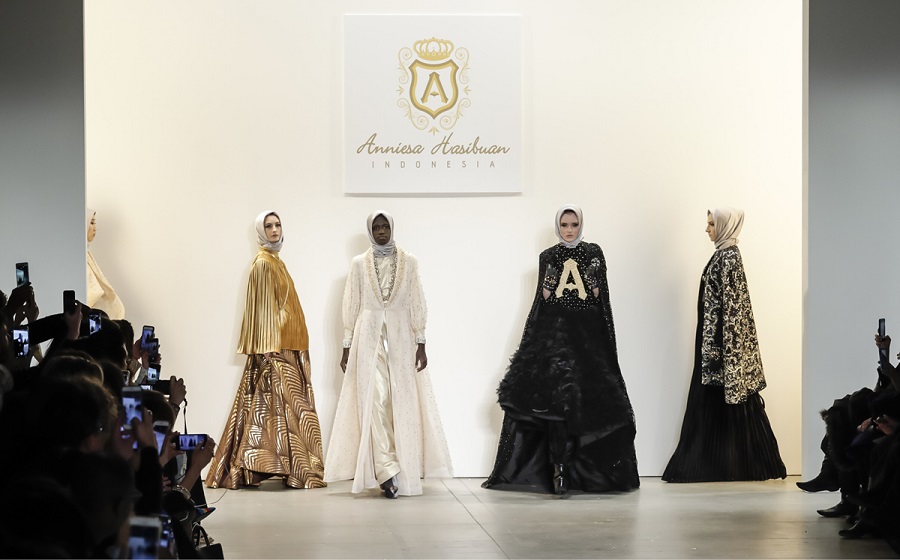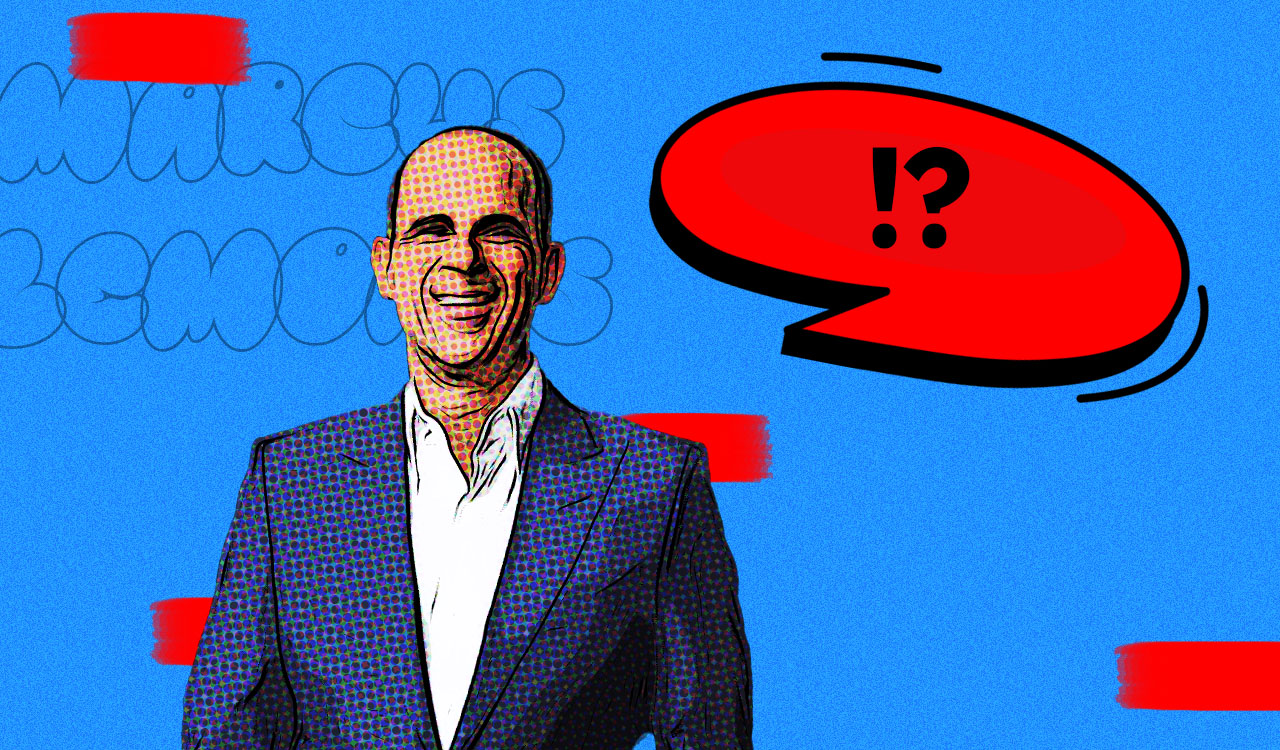At a much-anticipated show in New York in February, models sashayed down the runway in loose-fitting dresses made of opulent textiles adorned with jeweled trims and accessories.
Was it a Marrakesh-inspired collection of evening gowns in homage to Yves Saint Laurent? No, it was the New York Fashion Week debut of Vivi Zubedi, an Indonesian designer whose styles are all abayas, or loose robe-like dresses worn by women in parts of the Muslim world.
Modesty is having a fashion moment. Skimpy, tight-fitting clothing that leaves nothing to the imagination–a traditional sign of female liberation–is being replaced by high necklines, covered arms, wide-leg pants, and long dresses.
By almost anyone’s standards, modest fashion is a market on the rise, in part due to an increasing number of millennial Muslim women—or Generation M—who have larger amounts of disposable income, thanks to their new positions in the workplace rather than the home.
Modesty’s Religious Roots
The seeds of this movement were actually sown several years ago. In 2015 DKNY was among the first American brands to launch collections of hijabs and abayas, followed by Oscar De La Renta, and Dolce and Gabana the following year. At London Fashion Week in 2016, Indonesian designer Anniesa Hasibuan made history when she presented a collection where every model (all of whom were immigrants) wore a hijab on the runway. The use of ecommerce and social media has had a huge influence on the movement, as over 50 percent of the global Muslim population is younger than 25 years old, creating this demand for fashion online. Nike’s release of fashionable workout hijabs earlier this year was one of the most widely publicized indicators of the rise of religious influence on the fashion industry. It was a sign of female empowerment, and a necessary option for athletic women of the Muslim faith.
Big names like H&M and Mango have released modest clothing that appeals to this segment of the consumer market. British designer Hana Tajima released a modest fashion collection at Uniqlo, and the spring/summer 2018 collection using the company’s intricately designed fabrics includes floor-length dresses, high-waisted pants, and headbands under a scarf. Macy’s recently launched the Verona Collection, a brand from The Workshop, which is the company’s minority and women-owned business development program. With prices that range from $12.95 to $84.95, the line will feature cardigans, tops, dresses, pants, and hijabs. London-based RUH Collective is an elevated basics brand that produces clothing made of high-quality fabrics that does not cling to the body. It offers a home try-on Option and Everlane-like pricing transparency.
According to Reuters “State of the Global Islamic Economy Report,” and cited by Forbes, Muslim consumer spending on clothing is set to rise to $368 billion worldwide by 2021, a 51 percent increase from 2015 figures. This market is hard to ignore, as large companies must cater to this group, as well as to the other religious and cultural groups that abide by modest fashion rules and guidelines.
The e-tailer The Modist was launched in the spring of 2017. Hailed as the “Net-a-Porter” of modest fashion, the nondenominational site offers curated modest pieces from a continuously expanding group of luxury designers from Mary Kantrantzou and Marc Jacobs to Christopher Kane and Phillip Lim. Although many of its pieces are originals, The Modist has been known to ask designers to alter pieces to cater to their modest customers. Before founding the site, CEO Ghizlan Guenez worked in finance for many years, some of them in Dubai, and had trouble finding fashionable clothing even in the more-liberal United Arab Emirates. The business has reportedly grown rapidly, and now ships to over 120 countries.
Another success story is ModLi, a modest fashion marketplace that sources from hundreds of fashion boutiques. Not only does ModLi sell clothing that embodies modest standards, but it also showcases influencers from many different cultural and religious backgrounds who do the same on blogs and social media.
Other style icons have risen in the field, like Melbourne-based blogger Zulfiye Tufa, who calls herself The Hijab Stylist, with around 45,000 followers. She launched ModMarkit.com, which is a Poshmark-like app for modest fashion clothing.
Non-Denominational
Other religions have also contributed to the rise of modest fashion. Influencer Liz Roy (@downtowndemure) describes herself as: “Just a Christian chick from LA who <3’s [loves] modest + ethical fashion.” She’s been featured in the New York Times, People, Redbook, and Racked, and has 22,500 followers. Not only does Liz post her modest outfits, she also makes sure one-third of her posts are motivational quotes from powerful women like Oprah Winfrey and Malala. Liz, who is African-American, posts hashtags like #blackgirlmagic, and occasionally wears special pieces like a colorful blue skirt handmade by a seamstress in West Africa. She is motivated by both her devout Christianity and a desire to show the world that modest does not mean frumpy.
According to Bustle, fashion historian Daniel Cole sees the rise of modesty in fashion as part of the pendulum of cultural globalization. “During the second half of the 20th century, after World War II, in both Judaism and Islam, we saw a decrease in modesty customs. There was less adherence to it.” He notes that modest fashion on the runway has no precedent, and is ushering in a new era of fashion and culture. Bloggers have taken a variety of approaches to modest fashion. Some cite religion as their primary motivation. Others, feminism.
Unlike most Christian denominations, Judaism and Islam have religious texts on dressing modestly. This has created a more firmly rooted mindset of molding faith and fashion in everyday life. In 2015 Rachelle Yadegar and Judith Illulian launched a modest fashion company for Orthodox Jewish women called RaJu, right as the modest fashion movement began trending. The company, based on Los Angeles, focuses on bold colors and patterns, and curve-hugging silhouettes with luxurious fabrics, to demonstrate how fashion-forward and modest are not mutually exclusive. More brands catering to Jewish women have emerged from this idea, such as Mikah Fashion, an Italian-made line that focus on basics, and House of Lancry, a high-fashion brand that creates clothes that can be street or runway styles. Bari Mizmann (@barianna) is a Jewish modern style blogger whose tagline “A Modest Comeback,” reveals her commitment to the style and the culture surrounding the movement. She creates videos explaining how to secure her “tichel,” a headscarf, using tips and tricks, as well as posts of herself modeling modest clothing.
Secular Motivations
But it’s not just the religious consumer driving this growth. Increased consciousness about covering up certain parts of the body is also being embraced by the mainstream market.
“I feel it is about female confidence, that you can look good without going down the Kardashian route” said Louisa Smith, a Europe-based fashion forecaster who tracks apparel and fabric trends for many global companies. “There seems to be a return on the runways to craft and style. “Smith has been seeing a shift toward subtle femininity and lowering of hemlines and more covered effects. “It is subtly understated and soft, not a drastic shift, but definitely growing. I think this demure direction ties in with the interest of traditional values as well as to the appeal of dressing up compared to the tidal wave of athleisure styling that swamped the market.” Smith cited Alessandro dell\’Aqua\’s No 20 label, as well as Marni, Prada, and Gucci, as the standout runway collections that are gradually becoming more feminine yet covered.
Whatever the source, modest fashion is quickly losing its old-fashioned stigma, and looking very fashion-forward, a liberating direction for many women who want to embrace, for whatever reason, a new landscape that could change the dynamics of the female community for years to come. “It’s not just about covering up your body to defy the typical standards of beauty that our society has given us,” observes Erin, a twenty-three-year old marketing professional living in New York. “It’s about comfort, empowerment, and dressing in ways that allow us to do our best work. For some, that’s dressing modestly, but I can also say that this movement is not about limiting your fashion-forwardness.” Modest fashion brand RUH Collective founder Sonia Trehan posted on Instagram that the movement is about far more than just wearing pieces of clothing that hide certain areas of the body. It is about culture and values, and about understanding the various forms of the female experience.
On the date of the Modist launch, which not coincidentally occurred on International Women’s Day, founder Ghizlan Guenez released a statement: “Our mission is to build a strong sense of purpose to empower a woman’s freedom of choice and to acknowledge how similar women across the world are, despite our diverse backgrounds, cultures and lifestyles — a relevant conversation at this time.”



